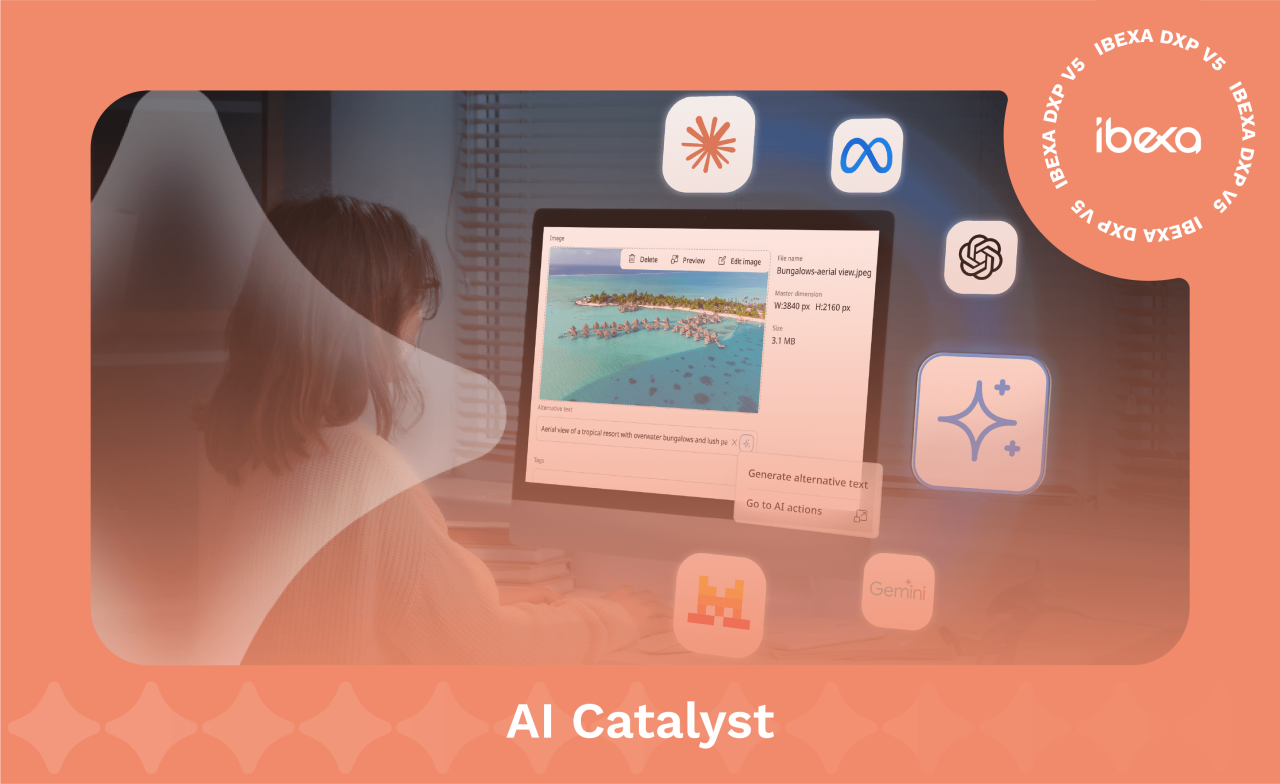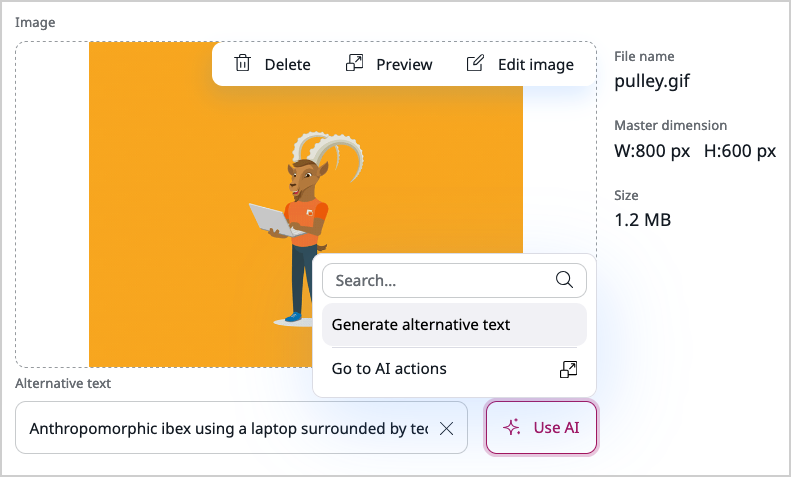Generating ALT Text and sharpening content with AI in Ibexa DXP

The Ibexa AI Catalyst framework contains a number of of tools to accelerate the execution of Go-To-Market strategies, personalise content and improve collaboration.
Today, we'll be looking at how to leverage AI inside of Ibexa DXP to improve SEO and accessability through ALT tagging and how to sharpen the focus of content to ensure your messaging resonates with your target market. Let's jump in!
Have you ever had to write ALT texts for your content pieces?
Then you probably know that it can be quite a tiresome chore. Thankfully, that’s one task that can be fully automatized in Ibexa DXP.
Ibexa DXP contains a number of AI tools to improve ALT text generation, which can be executed individually or at scale using Ibexa Connect.
Ensuring all images have a descriptive text should be an essential part of your SEO and accessibility strategy. And with the advent of AI search, it’s likely going to be even more important to 'sign post' AI Search bots to connect the dots between images and the content on a particular page. Think of it as giving AI search a little bit of extra context.
As we've covered ALT text previously, we won't deep dive too much here on that subject.
Instead, let’s talk about the content generation capabilities available in Ibexa DXP and how you can leverage these to sharpen campaign messaging, improve product descriptions, and more.
GenAI in Ibexa DXP
LLMs such as Claude, ChatGPT and Le Chat are fantastic tools for content editors and marketers. Whether you use them as a sparring partner for campaign ideas or to rewrite/expand on existing content, they both increase efficiency in content creation and greatly assist in creating content at scale.
Right now, you're probably either using these chatbot tools directly to enter prompts (and possibly copying and pasting content) or maybe using Microsoft Copilot in Word. There are of course many CMSs out there that also have AI tools, with many of them using OpenAI for generative AI. Having tools like these directly integrated into the CMS or DXP interface has many benefits for context and of course efficiency, as it removes the need to copy and paste text between windows.
So, how does Ibexa DXP do it differently?
At Ibexa we have fully embraced AI tools, and being a composable DXP, you could say we've also made our AI Framework composable.
With AI Catalyst, you have the freedom and flexibility to use whichever model(s) you wish when it comes to generative AI.
In essence this means you can choose multiple models (or LLM's) depending on challenge that needs addressing.
Do you have a specific tone of voice or vocabulary you would like the models to stick to?
Sure thing – you can set things like tone of voice and governance to make sure they’ll be followed every time.
(Don’t worry, we'll be covering this area in a later blog, but if you want to deep dive into some of the techy aspects of this, you can check out this guide to AI Actions within the DXP.)
How it works
Here’s a short video on how this all looks inside of the DXP interface, briefly covering both ALT text generation and rewording:
As you can see, it's pretty straightforward to quickly refine or reword content in Ibexa DXP. Through Ibexa Connect, you can also set up further actions such as video to text, text to audio (and vice-versa) using any AI model with API access. Of course, the easiest to get started with is OpenAI and its tools (using the OpenAI Connector), but it is possible to add other models and get them working for you in Ibexa DXP.
So, the questions you may be asking are:
(a) Why have you taken this approach?
and
(b) Great! How do I get started with adding in my favourite model?
Let's cover that:
A) One of the main reasons for this approach is to give customers and developers flexibility to leverage any model. One model is not always a 'one size fits all' and allowing different LLM's allows you to leverage the right tool for the job.
Furthermore, a great model today may not be the greatest model in 6- or 12-months’ time, so we aim to ensure you've got the flexibility to switch models out if a more advanced tool comes along (or indeed, is more cost effective!).
We also recognise that many IT departments have policies that prohibit the use of models such as ChatGPT for security reasons, which is why our approach allows you to use private LLMs for increased content and data security.
B) Finally, to get started with this approach, you can use either the OpenAI connector (if you just want to use OpenAI tools such as ChatGPT, DALL-E or Whisper) or Ibexa Connect, our low code/no code builder tool which you can read about here.
Finally, if you are curious about playing with Local LLMs you might want to take a look Ollama or LM Studio. Both are free and prompts are kept private and on your local machine. We recommend using smaller models but both Ollama and LM Studio work great, particularly if you are using a mac with 'M' based processors.
[On-Demand Webinar] Introducing Ibexa DXP V5
|
|
|


